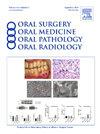临床侵袭性下颌骨骨质发育不良伴动脉瘤样单纯性骨囊肿(ASBC): 3例扩张性骨发育不良?
IF 1.9
3区 医学
Q2 DENTISTRY, ORAL SURGERY & MEDICINE
Oral Surgery Oral Medicine Oral Pathology Oral Radiology
Pub Date : 2025-07-21
DOI:10.1016/j.oooo.2025.04.080
引用次数: 0
摘要
骨水泥-骨发育不良(COD)是颌骨的一类良性纤维-骨病变,通常表现为无症状,大多数为非扩张性,界限清楚,混合放射性混浊/辐射率(RO/RL)或单眼RL。某些类型的人偏爱中年黑人和亚洲女性。一种非家族性COD表现出明显的、快速进展的颌骨扩张,被称为扩张性骨发育不良(EOD)。值得注意的是,EOD通常伴有并发动脉瘤样或单纯性骨囊肿(ASBC)(25%-45%)。材料和方法我们报告了3例下颌骨COD合并ASBC,其特征是广泛的骨扩张和破坏。结果3例患者均为非家族性黑人女性,年龄20 ~ 52岁,中位年龄36岁。影像学上,2例表现为多发性、分界性、单室或多室RL和/或混合性RL,累及整个下颌骨,伴扩张、皮质变薄和穿孔。第三位也是最年轻的患者表现为明显扩张的多室RL,伴有皮质变薄和小RO灶。1例患者最初表现为前下颌骨局部COD, 5年内病变进展迅速。组织病理学上,所有病例均表现为不规则形状,圆形至卵形营养不良,骨质或骨样钙化,伴有细胞和血管纤维胶原或纤维黏液样结缔组织。有或无多核巨细胞的重要编织骨的细长小梁排列的出血性囊腔。2例有多发下颌骨病变的患者被诊断为华丽型COD合并ASBC,而最年轻的患者被诊断为COD的EOD变体合并ASBC。结论seod是一种罕见的颌骨纤维骨性病变,其特点是进展迅速,骨质流失和扩张明显。由于其具有侵略性的临床行为,患者管理具有挑战性。本文章由计算机程序翻译,如有差异,请以英文原文为准。
Clinically aggressive cemento-osseous dysplasia (COD) of the mandible with associated aneurysmal-like simple bone cysts (ASBC): three cases of expansive osseous dysplasia?
Introduction
Cemento-osseous dysplasias (COD), a family of benign fibro-osseous lesions of the jawbones, commonly present as asymptomatic, mostly nonexpansile, well-demarcated, mixed radiopacities/radiolucencies (RO/RL) or unilocular RL. Certain types show predilection for middle-aged Black and Asian women. A form of nonfamilial COD exhibiting marked, rapidly progressing jawbone expansion has been reported under the term expansive osseous dysplasia (EOD). Notably, EOD is frequently associated (25%-45%) with concurrent aneurysmal-like or simple bone cysts (ASBC).
Materials and Methods
We present three individuals with mandibular COD associated with ASBC characterized by extensive bony expansion and destruction.
Results
All 3 cases were nonfamilial and affected black-African women 20-52 years of age (median age: 36 years). Radiographically, 2 cases exhibited multiple, demarcated, unilocular, or multilocular RL and/or mixed RO/RL involving the entire body of the mandible with associated expansion, cortical thinning, and perforation. The 3rd and youngest patient presented with a markedly expansile multilocular RL with cortical thinning and small RO foci. One of the individuals, who presented initially with localized COD of the anterior mandible, showed rapid lesional progression within 5 years. Histopathologically, all cases featured irregularly shaped, round to ovoid dystrophic, cementum- or bone-like calcifications associated with cellular and notably vascular fibrocollagenous or fibromyxoid connective tissue. Hemorrhagic cystic spaces lined by slender trabeculae of vital woven bone with or without multinucleated giant cells were present. The 2 individuals with multiple mandibular lesions received a diagnosis of florid COD with ASBC while the youngest patient was diagnosed with the EOD variant of COD with ASBC.
Conclusions
EOD is an uncommon form of fibro-osseous lesion of the jaws characterized by rapid progression with significant bone loss and expansion. Patient management is challenging due to its aggressive clinical behavior.
求助全文
通过发布文献求助,成功后即可免费获取论文全文。
去求助
来源期刊

Oral Surgery Oral Medicine Oral Pathology Oral Radiology
DENTISTRY, ORAL SURGERY & MEDICINE-
CiteScore
3.80
自引率
6.90%
发文量
1217
审稿时长
2-4 weeks
期刊介绍:
Oral Surgery, Oral Medicine, Oral Pathology and Oral Radiology is required reading for anyone in the fields of oral surgery, oral medicine, oral pathology, oral radiology or advanced general practice dentistry. It is the only major dental journal that provides a practical and complete overview of the medical and surgical techniques of dental practice in four areas. Topics covered include such current issues as dental implants, treatment of HIV-infected patients, and evaluation and treatment of TMJ disorders. The official publication for nine societies, the Journal is recommended for initial purchase in the Brandon Hill study, Selected List of Books and Journals for the Small Medical Library.
 求助内容:
求助内容: 应助结果提醒方式:
应助结果提醒方式:


